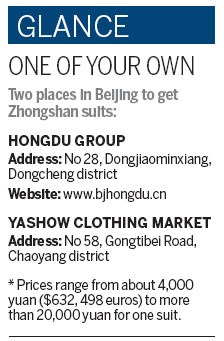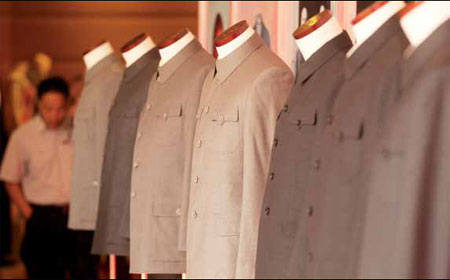Custom made
Updated: 2012-05-25 09:04
By Chen Yingqun (China Daily)
|
||||||||
|
Designers are introducing slight changes to the Zhongshan suit to reflect individual personalities and temperaments. Dai Bing / for China Daily |

Classic Chinese tunic continues to be fitting choice in contemporary times
Chinese tailor Gao Liming has plans for a big order in Europe this September. The 54-year-old is set to make a suit for George Abela, president of Malta. But it will not be any ordinary attire - Gao will be fitting Abela with a classic Zhongshan Chinese suit, known for its four front pockets and clean-cut collar. It was after seeing Cai Jinbiao, China's ambassador to Malta, who was in a Zhongshan suit when he presented his credentials to the president last month, that Abela decided to have one made for himself.
"He thought the suit looked nice, so he asked me to make one," says Gao, a tailor with clothing company Hongdu Group, who also made Cai's suit.
Abela is just one of the latest foreigners to show an interest in the classic Chinese menswear. For the past decade, dozens of Westerners have headed to Hongdu's store in Beijing alone to have Zhongshan suits made.
Many Chinese people have similarly revived their interest in the suit, with top leaders and other luminaries sporting the garb on major occasions.
On Oct 1, 1999, then president Jiang Zemin wore a Zhongshan suit for the National Day parade to celebrate the 50th anniversary of the founding of the People's Republic of China. Many men, especially those in their 40s and 50s, soon followed his lead and picked out Zhongshan suits for themselves, Gao says.
Hongdu, which is famous for making Zhongshan suits for Chinese leaders, such as Mao Zedong and Jiang Zemin, says it has witnessed a marked increase in the number of suits it has sold in the past three years.
When President Hu Jintao showed up on Oct 1, 2009 in a Zhongshan suit to mark the nation's 60th anniversary, interest in the suit grew. The next day, buyers made a beeline to Hongdu for their own Zhongshan suits. The 100 suits that were of the same color, design and material as the one that President Hu wore were sold out in just a few weeks, Gao says.
The Zhongshan suit, which is also known as the Mao suit, was first introduced by Sun Yat-sen, the leader of China's 1911 Revolution. Mao later popularized the suit following the founding of the People's Republic of China.
In line with the suit's cultural significance in modern China, it has a vertical lapel that should always be fastened tightly to indicate the attention to detail and precision of the Chinese people. The four front pockets are said to symbolize the sense of propriety, justice, honesty and honor of the Chinese.
The two top pockets sport flaps that look like inverted pen-holders to show that the success of the Chinese revolution relied on the efforts of intellectuals, says Liu Yuanfeng, vice-president of the China Fashion Association.
The buttons on the front and cuffs also help the suit present a close fit.
"The Zhongshan suit was popular among intellectuals as soon as it appeared," Liu says.
"Its many connotations cater to their spiritual pursuit and the delicate design goes well with their aesthetic standards."
Following the founding of New China, government officials followed Mao's lead and regarded the Zhongshan suit as an official dress for important occasions - and the public soon followed.
"During the 1960s and 1970s, almost all men in China were wearing it," recalls Chen Kongtan, a 75-year-old teacher in Beijing. "Dark, gray and green suits could be seen everywhere."
The Zhongshan suit that was popular during that time was generally more loose fitting and comfortable than its modern counterpart. It also had five buttons to indicate the five stars on the national flag, Liu says.
"In China, the Zhongshan suit is considered a most suitable dress for leaders. It symbolizes solemnity, generosity and steadiness, which are characteristics that leaders need," Liu says.
Chinese leaders have justifiably held the suit in high regard.
Tang Mingxin, vice-president of the Association of Former Diplomats of China, says he was performing translation work for former premier Zhou Enlai one day, when he felt his throat was dry and unbuttoned the top of his Zhongshan suit.
"Zhou noticed my behavior and asked my supervisor to tell me after the meeting that the Zhongshan suit's tight collar symbolizes the precision we should adopt to govern the country. As such, we should not wear it too casually by leaving the collar undone," he says.
With the country's reform and opening-up from the late 1970s, the Zhongshan suit gradually lost its large following and was replaced by Western-style suits and more casual attire.
"There was a time when Chinese people thought that everything overseas was great and they lost confidence in their own culture," Liu says.
But with the country growing in importance and influence on the international stage, more people are returning to Chinese culture and the Zhongshan suit. The suit has also been adapted to suit current tastes.
While the pattern and color of Zhongshan suits designed for official occasions remain close to the original style, designers are introducing slight changes to reflect individual personalities and temperaments, Gao says.
For example, in the past, the shape and width of the collar of the suit were the same, but now it depends on individual preferences.
Some people, especially celebrities and youngsters, are in favor of Zhongshan suits that show more individuality. Bold colors such as red, yellow and white are being used. Some additions, including dragon, phoenix and peony motifs, are embroidered on the suits. The pockets are folded inside and the fabric choices are more varied to expand the scope of the design.
The Zhongshan suit has also inspired the designs of other clothes. Liu says some of his colleagues borrow the pockets and collar of the Zhongshan suit for their own designs.
The Hongdu Group holds an annual fashion show every year, and meetings where people can discuss the future of the suit.
However, Lu Peixin, the former Chinese ambassador to Slovenia, says it is not realistic to expect the suit to become as popular as it was before.
"China should still pay due respect to this national attire, and it will be good for people to wear Zhongshan suits on diplomatic occasions and major holidays," he says.
chenyingqun@chinadaily.com.cn
(China Daily 05/25/2012 page18)

 Relief reaches isolated village
Relief reaches isolated village
 Rainfall poses new threats to quake-hit region
Rainfall poses new threats to quake-hit region
 Funerals begin for Boston bombing victims
Funerals begin for Boston bombing victims
 Quake takeaway from China's Air Force
Quake takeaway from China's Air Force
 Obama celebrates young inventors at science fair
Obama celebrates young inventors at science fair
 Earth Day marked around the world
Earth Day marked around the world
 Volunteer team helping students find sense of normalcy
Volunteer team helping students find sense of normalcy
 Ethnic groups quick to join rescue efforts
Ethnic groups quick to join rescue efforts
Most Viewed
Editor's Picks

|

|

|

|

|

|
Today's Top News
Chinese fleet drives out Japan's boats from Diaoyu
Health new priority for quake zone
Inspired by Guan, more Chinese pick up golf
Russia criticizes US reports on human rights
China, ROK criticize visits to shrine
Sino-US shared interests emphasized
China 'aims to share its dream with world'
Chinese president appoints 5 new ambassadors
US Weekly

|

|








